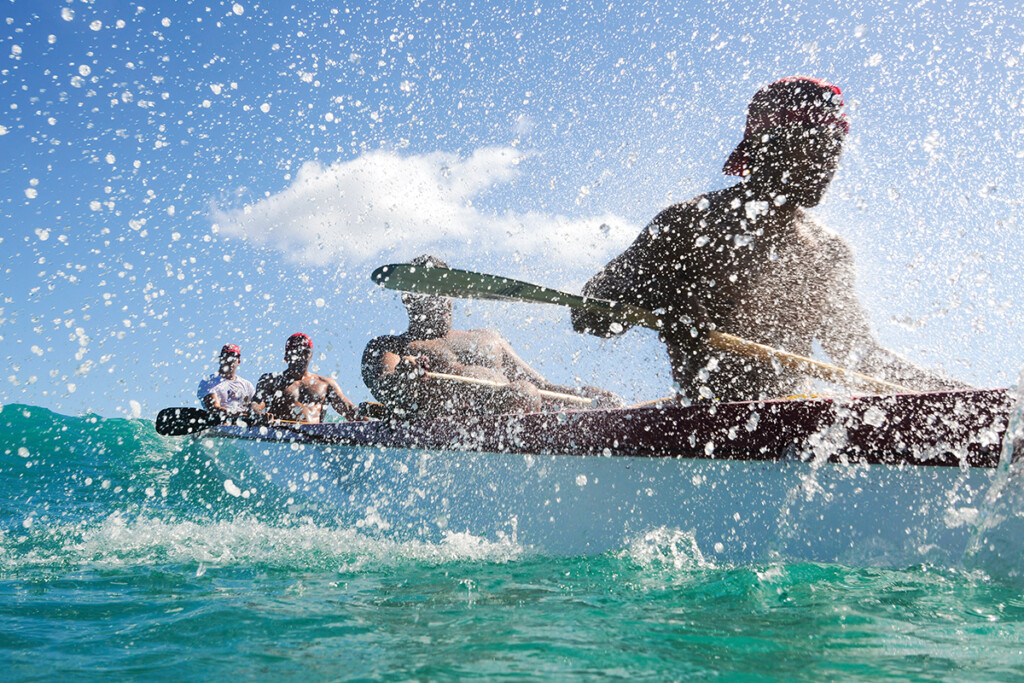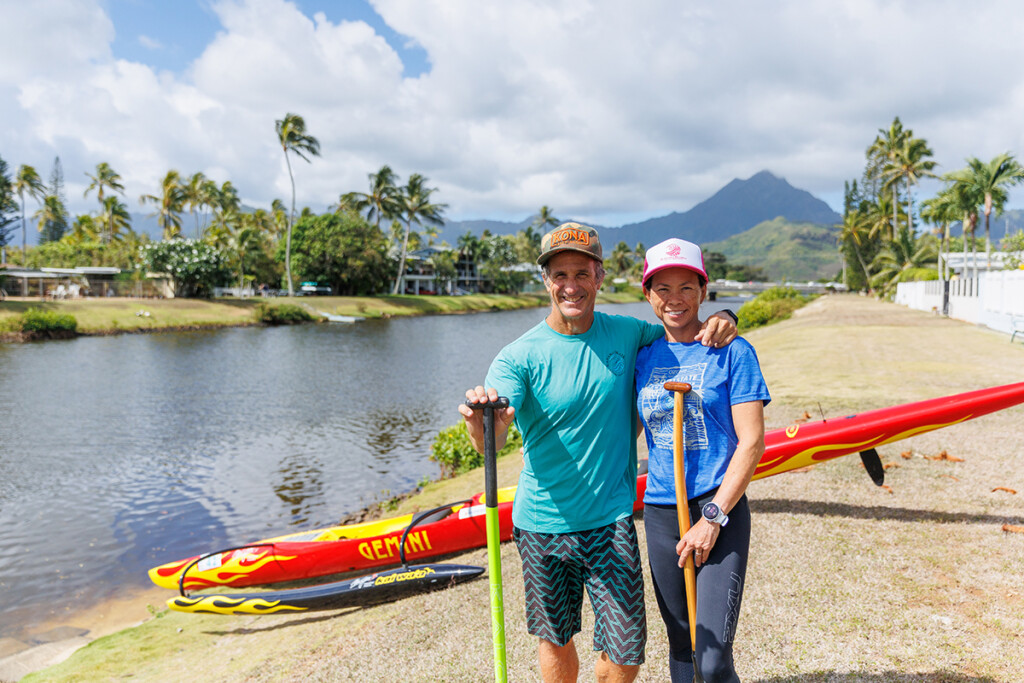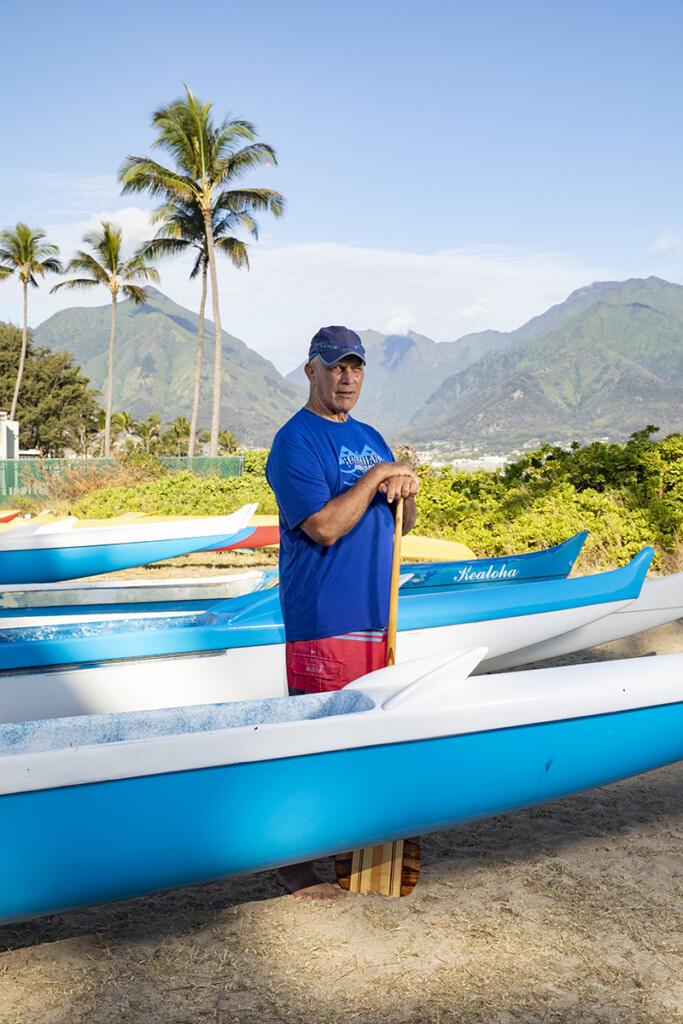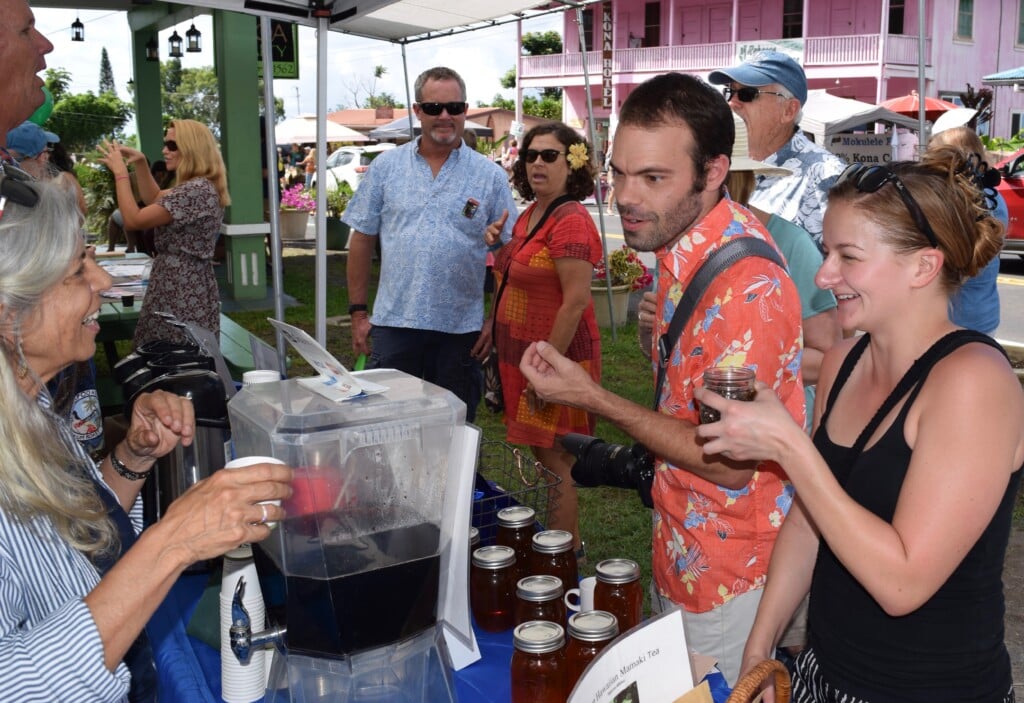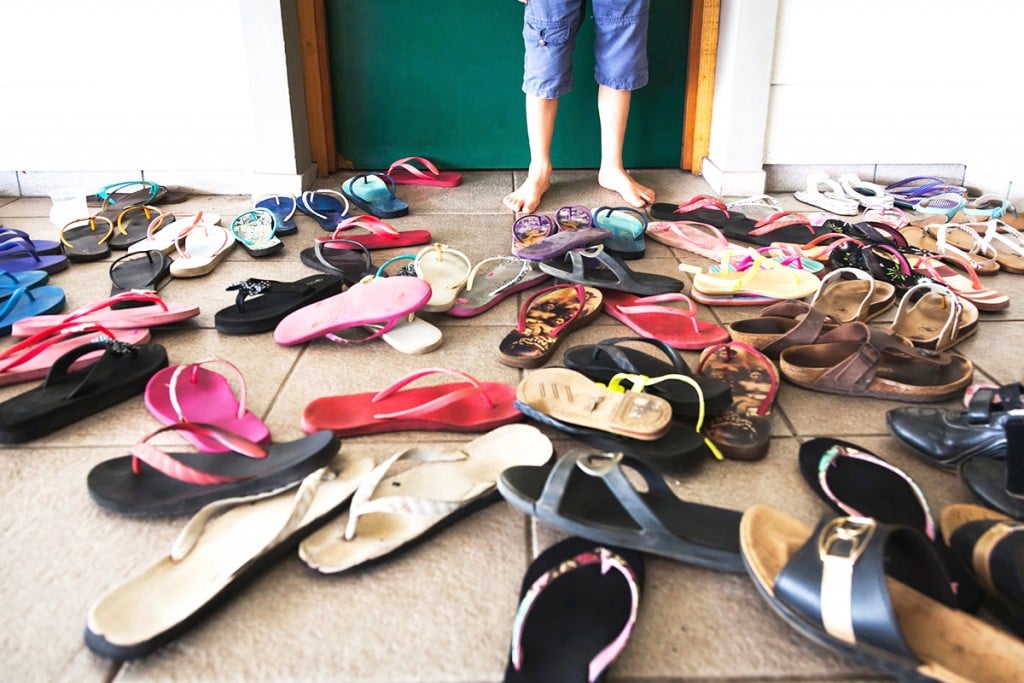Ready to Hammer: An Inside Look at Hawaiʻi’s Outrigger Canoe Community
After two canceled seasons, outrigger canoe regattas returned last summer in full force.
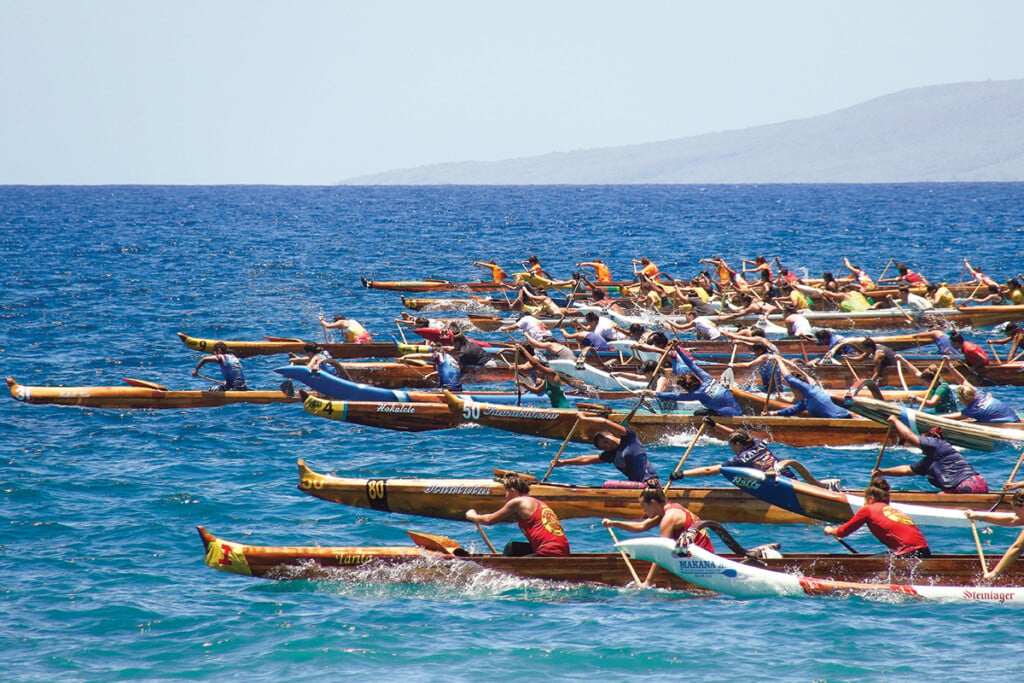
Moments before the regatta’s start, everything is quiet and still. Six-person canoes line up next to their lane flags, each steadied by boat holders, one treading water at the nose, the other at the tail. The paddlers avoid looking at the competition; instead, they grip their paddles tightly, eyes forward. The wind silently pushes ripples of water against the canoes. Then, finally, the starter on the officals’ motorboat waves a series of flags: Red. Yellow, yellow, yellow. Green! The canoes leap off the line like horses out of the gate. And the crowd on the beach roars. Steersmen bark at their crews: “Reach it out! Lock it in!” The race is on.
It’s a well-worn joke among outrigger canoe paddlers that they can race for an hour and talk about it for a week. Ask any diehard paddler about Hawai‘i’s official team sport, and he will rattle off a hundred reasons why paddling is his religion and the ocean is his church. The sport involves a blend of physical, mental and spiritual elements: the power of the blade grabbing water, the determination to push to the finish, the positive energy that allows a crew to blend. When those dynamics come together, the paddler feels the weightless glide of a 400-pound canoe plying through the water, and in those moments, well, everything is awesome.
“Paddling is versatile. It’s family. It’s multigenerational. It’s international,” says Joey Foti, a member of Lanikai Canoe Club on O‘ahu’s Windward Side. She and her husband, Jim, are elite paddlers who help coach the kids at Lanikai. They also distribute boats for global canoe manufacturer Outrigger Zone and run the nonprofit Kanaka Ikaika Racing Association, which holds 14 races a year, predominantly for solo vessels like surfskis, one- and two-person canoes and stand-up paddleboards.
“It’s networking. It’s cultural. It’s got so much richness to it. It’s not just a sport. What you sign up for is a lifestyle,” says Jim Foti, whose kids grew up associating the canoe with fun family excursions to the Mokulua islets off Lanikai. “I try to encourage people, ‘Hey, go have fun.’ As they develop, they realize, ‘Wow, I’ve been having so much fun doing this that I’m actually pretty good at it.’ When racing is a byproduct that comes from your love of it, then you’re going to race better, and all that’s just gravy.”
During regatta season, the Islands’ most spectacular bays—from Hilo to Hanalei—become arenas for weekly regattas (visit HCRApaddler.com for race schedules). Canoe clubs in coastal communities throughout Hawai‘i send paddlers of all ages (from under 10 to over 80) to compete in sprints that range from a quarter-mile to 1 ½ miles. Clubs take turns hosting regattas, each involving a full day of racing, music, food and camaraderie.
The outrigger canoe, or wa‘a, is at the root of Hawaiian history. Traditionally carved out of a single koa log and lashed together with plant fibers, its design offers both the strength and flex to endure big winds and swells. It was on double-hulled voyaging canoes that Polynesian mariners sailed across the Pacific, using the stars to navigate, and settled the islands of Hawai‘i—along with dozens of other islands spread across 10 million square miles of ocean.
“How did they get from Tahiti to here? There were no nails, no glue, no saws, no automation. They start making a canoe, it would take them years,” says Don Lee of Hawaiian Canoe Club in Kahului, Maui. “And no sextant. They took a chance not knowing where they were going—they were taught what to look for and what to do—and they just went for it! When you talk about the thousands of miles of open ocean in a double-hulled canoe? That to me is unbelievable.”
“Our tradition at Hawaiian is we do culture. Paddling is a huge, huge part of the culture,” Lee says, pointing to the club’s Kamali‘i program for youth paddlers. “The kids learn everything about the canoe. They’ll learn mele (songs) and oli (chants). They’re all taught the terminology—everything from ama (outrigger) to mo‘o (gunwale) to kaula (rope).” Each summer, the kids paddle canoes to neighboring Kaho‘olawe, where they help with restoration efforts by building a path that circles the island.
“Unless you know the history, you’re missing a lot,” Lee says. The education pays off—Hawaiian’s keiki (kids) crews have won the state regatta championship 35 years in a row.
When Lee started paddling in 1960, he could count the number of canoe clubs in Hawai‘i on two hands. Now going into his 62nd season, he marvels at the sport’s growth. Today there are more than 100 clubs scattered across Hawai‘i and the U.S. mainland, and the International Va‘a Federation, the governing body of international outrigger paddling, has 35 member countries, including Sweden, Brazil and Japan.
Paddles and canoes have also evolved. “Back in the day there was no paddle maker, no individuals making paddles. Clubs were responsible for paddles. Basically you would get a 2-by-2, 6 feet long, attach planks on both sides, and cut it and shape it,” Lee shares.
Jim Foti also recalls the big, heavy paddles that were once the standard. “We used to use oaf-y, wooden paddles that were, like, 3 pounds. Today we’re fighting over ounces. Equipment has evolved with materials getting lighter. Different design features have made boats even faster,” he says. Incredibly, the newest paddles weigh a mere 16 ounces, and an all-carbon six-man canoe is only 150 pounds—light enough for kids to carry.
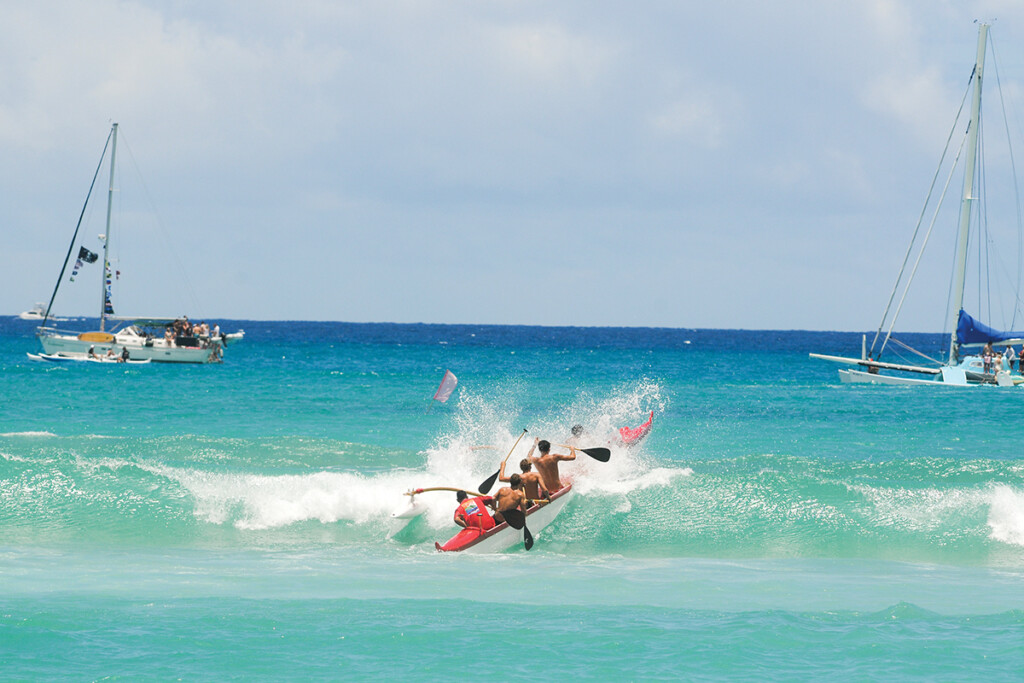
A moment from the Walter J. Macfarlane Memorial Canoe Regatta in 2019.
Photo: Courtesy of the Outrigger Canoe Club Historical Committee
Foti observes that paddling technique has also changed in tandem with lighter equipment. “We all still use our bodies. You can only veer so far from ‘put the paddle in and propel the canoe forward.’ It’s just different motions of the body and how your arms integrate” to find the most efficient way to wield the blade.
These advancements force paddlers to constantly adapt to new techniques. Since the sport takes a lifetime to master, it’s common for experience to trump youth. But while winning is always satisfying, what becomes most valuable for seasoned paddlers are the connections they make with others.
Lee goes through a roster of legendary paddlers, coaches and canoe builders he’s had the privilege to meet. He says, for him, the people he’s met over the past six decades have been the most meaningful part of paddling. “The saying goes, ‘Everybody has a story.’ I have crossed paths with so many other people who have amazing stories.”
The Fotis also give a nod to their close-knit community, which bonded even more tightly over the past two years. “During the pandemic, we thought business was going to skid when they shut down the world, but it had the opposite effect,” says Jim Foti. “All of a sudden, everybody was like, well, we’ve got more time, and we can’t do all these other sports, but they’re allowing
us to paddle. In Hawai‘i, the impact was everybody and their brother and sister wanted to get on the water.”
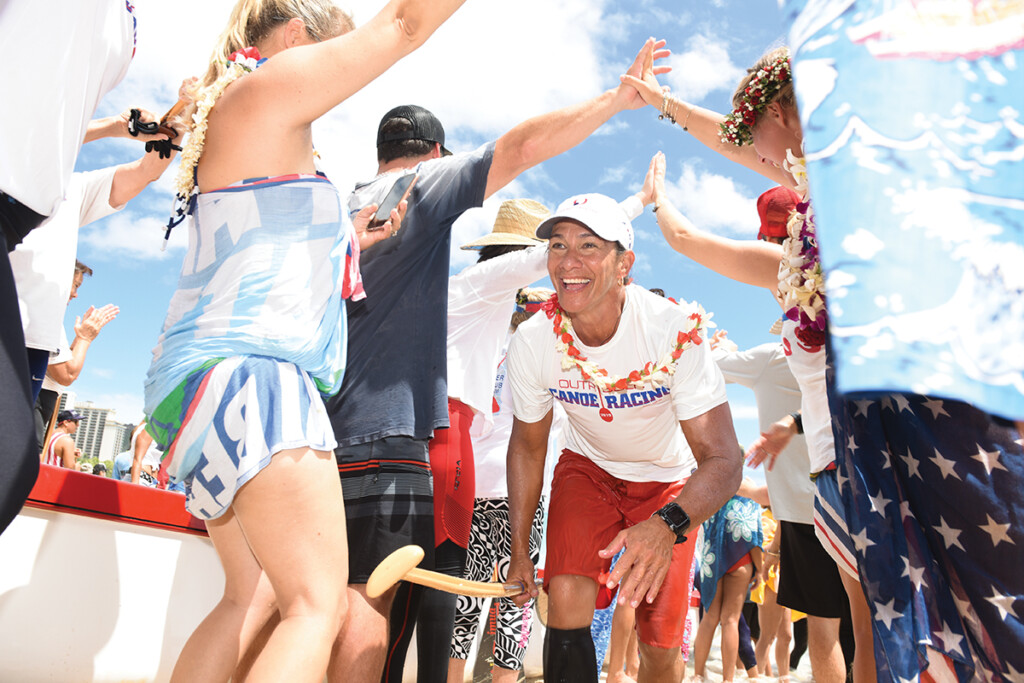
Community is just as important as paddling.
Photo: Courtesy of the Outrigger Canoe Club Historical Committee
Joey Foti says people pulled long-neglected boats and boards, covered in vines and stained by time, out from under their houses. “It was so funny, but it was also so great that we could still see each other on the water.” Kanaka Ikaika shifted its races to virtual mode, and competitors could turn in a race time using the course of their choice. For one of the relays, some participants picked partners from other countries. “It made us realize it’s a small world, and we’re really all connected,” she reflects.
Now that travel is opening up, paddling events are back on the calendar. In August, London will host the IVF World Sprints, the Olympics of paddling, which pits the fastest crews on the planet against each other. Hawai‘i, which competes as its own “country,” has a field of top contenders hungry to hammer.
The Fotis look forward to jumping back into the fray. “Paddling has taken me all over the world. I’ve made friends in close and far places,” Jim Foti says. His wife laughs and says: “Paddling takes you places, literally. You paddle? You’re going to get somewhere.”
